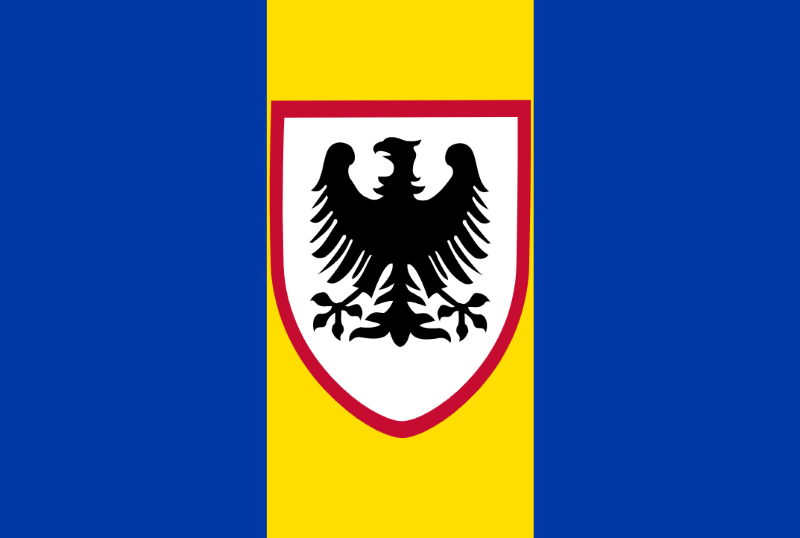| National Factbook |
| Flag: |

|
| Nation Name: |
Ravenfield |
| Leader Name: |
Mortheus Valixor |
| Currency: |

Euro |
| National Animal: |

Golden eagle |
| History: |
The Kingdom of Ravenfield was founded in 410 AD after the Romans abandoned Britain and Ravenfield (then called Dacanium). Its territory was mostly stable until the late 1500s when its expansion began into the Low Countries. It reached its apex in 1727, controlling parts of eastern England, the Netherlands, Belgium and the northern coast of France. In 1815-1822, a civil war resulted in Ravenfield losing most of its territory outside of Ravenfield. In the 1830s, a campaign started to regain territory in the Low Countries, and by 1885, Ravenfield was again controlling the Low Countries. This lasted until 1905 when the Low Countries declared independence in a brutal war that Ravenfield lost.
In WWI, the Kingdom of Ravenfield remained neutral, though it supported the Central Powers in the final months of the war. What followed was a massive uprising by former members of the banned Communist and Socialist parties, which the Kingdom was unable to resist despite international support. By 1925, the last King of Ravenfield was deposed and a Socialist Republic of Ravenfield was established.
In 1940, the German Reich invaded Ravenfield after a bombing campaign of several weeks. It would take years to recover from the invasion.
The SR of Ravenfield achieved some great feats, turning Ravenfield from an agrarian feudalist state, to a wealthy power comparable in wealth to Western Europe. This continued to today.
Certain governments claim that Ravenfield is just a conspiracy and the only thing that exists in its area is the North Sea. |
| Geography |
| Continent: |
Europe |
| Land Area: |
104,204.77 sq. km |
| Terrain: |
Mostly flat, with some hills in between, and in the center there is Mount Ravenfield. |
| Highest Peak: |
Mount Ravenfield,
1,840 meters
|
| Lowest Valley: |
Sea level,
0 meters
|
| Climate: |
Temperate, rainy all the time. |
| People & Society |
| Population: |
8,632,818 people |
| Demonym: |
Ravenfielder |
| Demonym Plural: |
Ravenfielders |
| Ethnic Groups: |
Ravenfielder - 99.5%
Other - 0.5% |
| Languages: |
Ravenfielder - 95.1%
Other - 4.9% |
| Religions: |
N/A - 56.4%
Ravenfield Paganism - 30.5%
Other - 13.1% |
| Health |
| Life Expectancy: |
74 years |
| Obesity: |
5.4% |
| Alcohol Users: |
28.6% |
| Tobacco Users: |
15.3% |
| Cannabis Users: |
3.5% |
| Hard Drug Users: |
0.9% |
| Economy |
| Description: |
1st 5-Year Plan (1930-1935)
The 1st 5-year plan of Ravenfield mainly focused on expanding heavy industry and resource production. It was personally coordinated by the President, though it would be later coordinated by a council of members. The plan was highly successful, exceeding the GDP growth goal by 7.0% to 5.9%. Productivity increased almost 50%, the amount of coal mined increased by 75%, social programs were initiated and universal healthcare was introduced. Such rapid growth resulted in envy and horror from the capitalist West, which was suffering from the Great Depression at the time.
2nd 5-Year Plan (1935-1940)
The 2nd 5-year plan was slightly less successful than the 1st plan, though some of this can be attributed to the 2nd World War. This plan mostly coordinated on expanding the consumer goods industry, which were utterly insufficient under the Kingdom. GDP growth continued to be above 6%, productivity increased by 7% a year, mining almost doubled during this period, and many state-owned companies were founded during this period, including Ravenfield Car Company, Grain Company of Ravenfield, Ravenfield Plane Company, Sodriss Food Products and more.
3rd 5-Year Plan (1945-1950)
The 3rd 5-year plan was expected to start in 1940, but the Nazi invasion put these plans on hold until Ravenfield was liberated in 1945.
The results of the 3rd 5-year plan were somewhat disappointing, but would recover under the 4th plan. The 3rd plan focused on maximizing heavy industry production and consumer goods production at the same time, as well as increasing food production. GDP growth average was 5.7%. During this period the productivity increased by 28% and food production almost quintupled, turning Ravenfield into a net exporter of food.
4th 5-Year Plan (1950-1955)
The 4th 5-year plan saw the beginning of the end of colonialism, dooming many capitalist countries unless they adapted.
The 4th 5-year plan was the most successful plan since the 1st 5-year plan. It continued to focus on increasing consumer goods production and improving the inferior technology of the country. The GDP grew at an average of 6.4%, consumer goods production increased by 50%, and technology was brought up to western standards.
5th and 6th 5-Year Plans (1955-1965)
These plans saw the fall of the Ravenfielder colonial empire, ending one of their main sources of profit.
The 5th and 6th 5-year plans were mainly focused on transitioning Ravenfield's economy from a colonial-based one to one that could sustain itself industrially. Oil production was prioritized during this period, and consumer goods also received some priority. GDP growth was 5.7 and 5.1% respectively. Car production increased from 562,000 in 1954 to 1,270,000 in 1967, its high-quality goods being exported around the world. Computers became a primary part of Ravenfield's economic management.
7th, 8th and 9th 5-Year Plans (1965-1980)
These plans focused on consumer goods and further increasing grain exports. Growth started to stagnate during this period due to the oil crisis, despite the increased oil production of the 5th and 6th 5-year plans. GDP growth decreased from 5.5% in 1964 to 4.1% in 1980, way short of the target of 5.7% in both cases. Productivity started to peak due to the stagnant population of Ravenfield in this period.
10th 5-Year Plan (1980-1985)
During the 10th plan, heavy industry was prioritized for the last time. GDP growth increased from 4.1% to 6.4% by 1985. Coal mining slowed down due to the country's coal mines being emptied by excessive mining. By 1985, Ravenfield was producing almost 4,000,000 cars, 800 planes, 200,000 trucks, 1,000 ships a year.
11th 5-Year Plan (1985-1990)
During the 11th plan, the Soviet Union, one of the main supporters of Ravenfield began to collapse. This spelled doom for the five-year plans of the country.
The 11th 5-year plan saw the decline of Ravenfield's socialist system, fueled by revisionists and right-wingers, possibly also funded by the United States. Consumer goods continued to be a priority of the 11th plan. GDP growth was 5.7% in 1990. In this period, computers were all the rage in Ravenfield. A network similar to the internet of today covered all of the country and parts of other countries. Technology was developing fast.
12th 5-Year Plan (1990-1992)
The 12th five-year plan only lasted two years due to the collapse of the USSR and the rise of pro-capitalist parties. These parties shredded up all of the 12th plan, ending it effectively.
Post-plan Ravenfield (1992-)
The country of Ravenfield, now capitalist, suffered heavily from the collapse of the 5-year plans. Unemployment skyrocketed and GDP growth fell from 4.5% in 1992 to 1.3% in 1995 to -0.9% in 1997. The GDP growth would never recover the levels seen during the period of the planned economy, staying at 1 to 2% a year.
|
| Average Yearly Income: |
$177.49 |
| Gross Domestic Product (GDP): |
$10,392,034,858.00 |
| GDP per Capita: |
$1,203.78 |
| Gross National Income (GNI): |
$5,822,909,605.00 |
| Industries: |
In the primary sector, the main producer of Ravenfield's wealth is mining unobtainium ore, which is turned into pure unobtainium, phlebotinium and explodium at an undisclosed location in Latveria. Other sources include mining dacanite, which is refined into Ravenfieldium, a highly explosive substance used as a substitute for nuclear weapons.
The secondary sector mainly consists of planes from Ravenfield Plane Co., which are criticized for falling apart seconds after taking off.
The tertiary sector mostly consists of highly illegal, high-tech AI research. This is mostly done in a miles-tall building that has sunk 100 meters since it was finished. |
| Military |
| History: |
The military of Ravenfield in its modern form was founded in 1822, after the civil war, though Ravenfield has had an army since the times of Caesar. |
| Soldiers: |
450,000 |
| Tanks: |
33,000 |
| Aircraft: |
2,235 |
| Ships: |
0 |
| Missiles: |
8 |
| Nuclear Weapons: |
0 |
| Last Updated: 03/20/2018 04:23 am |



















